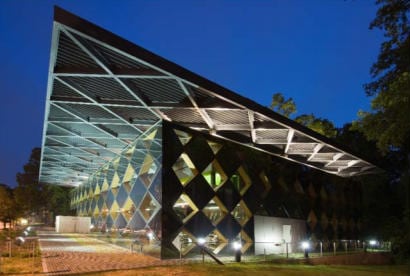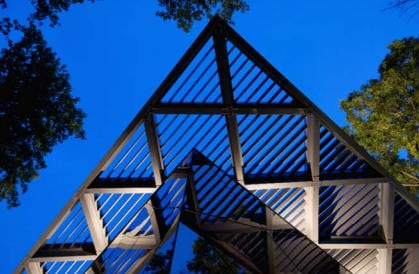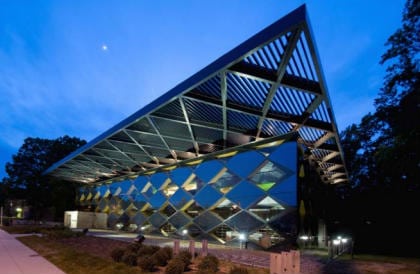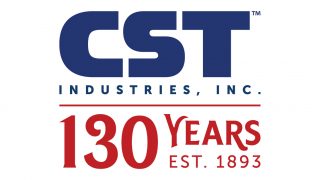 Take a bucolic woodland setting in the heart of a bustling metropolitan center. Inject a generous amount of energy and an open-minded, inclusive vision and combine with a shared sense of community and a passion for knowledge and you have the blueprint for the new Francis Gregory Library, a branch of the Washington, DC Public Library system.
Take a bucolic woodland setting in the heart of a bustling metropolitan center. Inject a generous amount of energy and an open-minded, inclusive vision and combine with a shared sense of community and a passion for knowledge and you have the blueprint for the new Francis Gregory Library, a branch of the Washington, DC Public Library system.
Situated in Fort Davis Park where a Civil War fort once stood, this iconic 25,500-square-foot structure is an elegant yet accessible gathering place for local residents – a re-imagining of what a library can be. The new Francis Gregory Library is stunning, beguiling, welcoming, and complements its leafy surroundings. Architectural Record calls it “a shimmering pavilion.” Local news outlet DCist wrote “it’s almost hard to believe this is a D.C. government building.”
Part of a $178M system wide construction and renovation campaign, Francis Gregory Library was designed by world-renowned architect David Adjaye and his team at Adjaye Associates. Adjaye comes with impeccable credentials and also designed the new National Museum of African-American Culture at the Smithsonian. His specialties are civic, cultural and educational institutions, as evidenced by his passion for libraries.
“Our mission [is] to offer a new way to experience books, reading and storytelling,” says Adjaye. “Rather than a traditional closed building, this library is porous and open, with the canopy providing a welcoming entrance that invites people inside. Conceived as an extension to the park, it is not only a place to gather, but also a place of contemplation and learning.”
The visionary structure is a testament to the classic elegance of geometry, employing repeated shapes throughout and crowned with a “muscular, louvered aluminum canopy,” according to Architectural Record. Indeed, the canopy has won acclaim because it is a signature element – one of the features you first notice when you lay eyes on the building. It’s described as an architectural sunshade, much like a pergola or lattice roof.
 Built by CST Covers, the worldwide leader in the design, manufacture and construction of custom aluminum structures, the canopy is a feat of design and engineering. Architectural plans called for the canopy to have a 34-foot cantilevered overhang on the front of the building, 12 feet of overhang on the sides and 16 feet at the rear of the building. According to CST project designer Michael Gamber, that’s a significant amount of unsupported mass, and he adds that Adjaye’s vision of a dramatic overhang created an engineering challenge which required visioning in its own right.
Built by CST Covers, the worldwide leader in the design, manufacture and construction of custom aluminum structures, the canopy is a feat of design and engineering. Architectural plans called for the canopy to have a 34-foot cantilevered overhang on the front of the building, 12 feet of overhang on the sides and 16 feet at the rear of the building. According to CST project designer Michael Gamber, that’s a significant amount of unsupported mass, and he adds that Adjaye’s vision of a dramatic overhang created an engineering challenge which required visioning in its own right.
So Gamber, along with CST engineer Jerry Watson, took the architectural plans and swung into action.
“The architect has a specific vision and it’s our job to give it bones, to make it structurally sound and bring it to life,” says Watson. “The design envisioned a grid of irregular diamond shapes constructed from tubular framing, but we found that structurally we couldn’t simply connect hundreds of diamond shapes and provide adequate support for the cantilevered condition.”
After exhaustive analysis, Watson developed a wireframe showing a strategically placed array of aluminum tubes in the shape of diamonds, connected by gussets and secured with bolts. He provided Gamber with data illustrating the connection requirements of every tube, gusset and bolt. Gamber then input the data into a program which created an accurate 3D computer model of the entire structure which then generated computer code that instructed machines to cut the raw materials to exact specifications. In all, there were 896 tubes connected by 454 gussets and secured by 23,500 bolts.
Because of the canopy’s sizeable overhang, the CST team applied physics and a healthy respect for gravity to their design. Absent this special design, the canopy would sag around its unsupported edges. So Gamber and Watson developed a specific pattern for bolting the tubes so the canopy would curve upward at its edges after assembly. This is called pre-camber, and Gamber says there was an unusually large amount of it. A series of jacks were employed during assembly – simulating zero gravity – and when the jacks were removed and the canopy put in place and subjected to gravity, the curve disappeared and the edges straightened perfectly.
Due to the irregular shape of the canopy – the diamonds decrease in size from the front to the back – no two tubes are the same or bolted exactly the same way, yet all the components work together in perfect harmony. To achieve this perfect union, CST used analysis software to model the complex bolt pattern and automated the 3D models with Pro/Engineer design software.
 “What’s extraordinary is how we exchanged data between the two software programs,” says Gamber. “There was real magic in the level of detail transferred from the analysis software and the 3D modeling and manufacturing software.”
“What’s extraordinary is how we exchanged data between the two software programs,” says Gamber. “There was real magic in the level of detail transferred from the analysis software and the 3D modeling and manufacturing software.”
Gamber continues: “Every step of the way, we kept the architect’s vision top of mind and did everything in our power to translate that vision without compromising it in any way. We understood the excitement around the vision and shared in that excitement; it was rewarding to create something that’s not only functional but memorable and lasting.”
Aluminum was a wise choice because it’s non-corrosive, lightweight, durable and adapted well to the design requirements. The tubes were created through an extrusion process; pre-heated aluminum was passed through a die using hydraulic pressure to create a customized shape. Plans called for 24-inch deep tubes, but 12-inch tubes are the largest the press can extrude, so two 12-inch thick tubes were mechanically fastened together. Besides the ability to create hundreds of tubes to exacting standards, utilizing extrusions reduces overall fabrication time and reduces waste.
“We always say we put the metal where it’s needed,” says Grace Ferretti, Architectural Sales Manager and Design Consultant at CST. “This project demonstrates CST’s passion for applying our expertise to an architectural vision and creating a structure that is the embodiment of that vision.”
In addition to its beauty, the canopy also contributes to the building’s sustainability, providing shade in the summer and catching warm sunlight in the winter. It plays a key role in helping the building earn LEED Silver certification for its commitment to intelligent energy use and environmental stewardship. Plus, more than half the aluminum is fabricated from recycled content.
In addition to the marvels of its design and functionality, Francis Gregory Library has already become an enduring symbol of stability in the community. When last summer’s derecho storm knocked out power for nearly half a million utility customers in the area, patrons flocked to the library because it was the only place with power. The library served as a refuge for residents – to connect their laptops and charge their phones – and usership has been strong ever since.
Francis Gregory Library has been heralded by architectural design critics and experts. Fast Company’s Co.Design calls it “a new neighborhood library … [which] reminds us of the pleasures of a beautiful reading room.” Thanks in part to the welcoming and visually arresting canopy engineered by CST, you can tell this book by its cover.
From Concept to Completion:
CST provides the creative assistance you need to ensure your project is completed on time and within budget.
- Design—Working closely with your project team, our design consultants can help turn your concept into a creative and cost effective solution. We know every project is different and we use proprietary 3D modeling software to assure we present the best structural options for your most specific needs.
- Engineering— From proof to concept to final structural design, our team of professional engineers ensures your ideas become reality. In facing any design challenge, our engineers strive to meet your design requirements as efficiently and economically as possible.
- Fabrication—Utilizing a state-of-the-art fabrication facility and maintaining stringent production standards and controls, we bring a level of quality to your project that brings your design to life.
- Installation— Our lightweight aluminum components, proprietary assembly processes and specialized construction equipment bring an unmatched level of quality and efficiency. At any given time, our crews and construction consultants are working at sites around the world.
Contact Information:
CST Industries, Inc.
844-44-TANKS
sales@cstindustries.com

